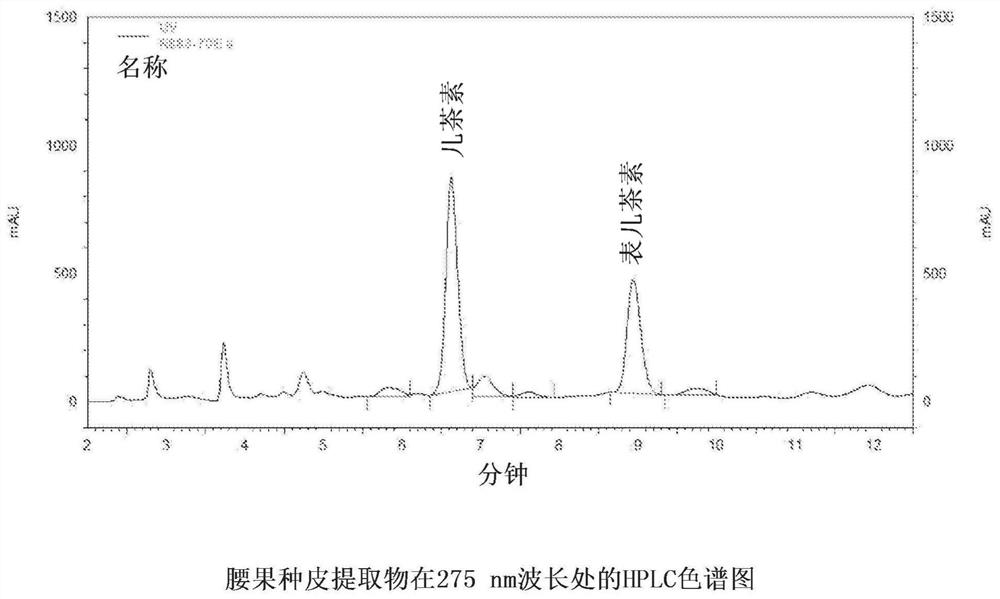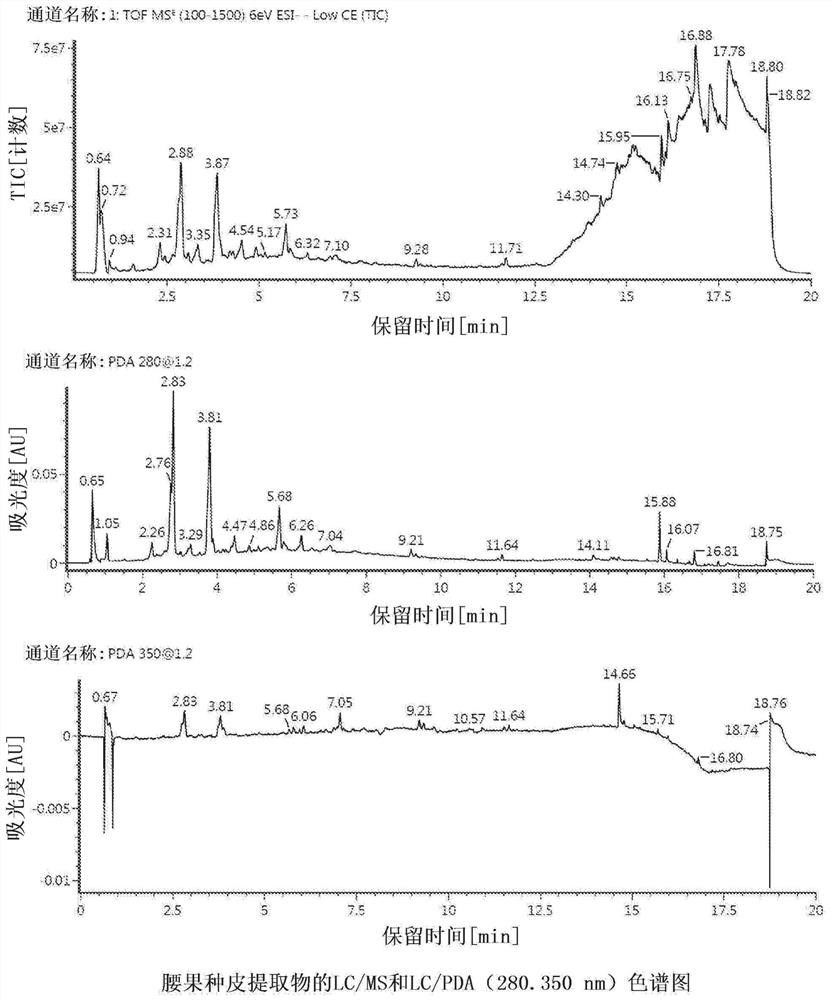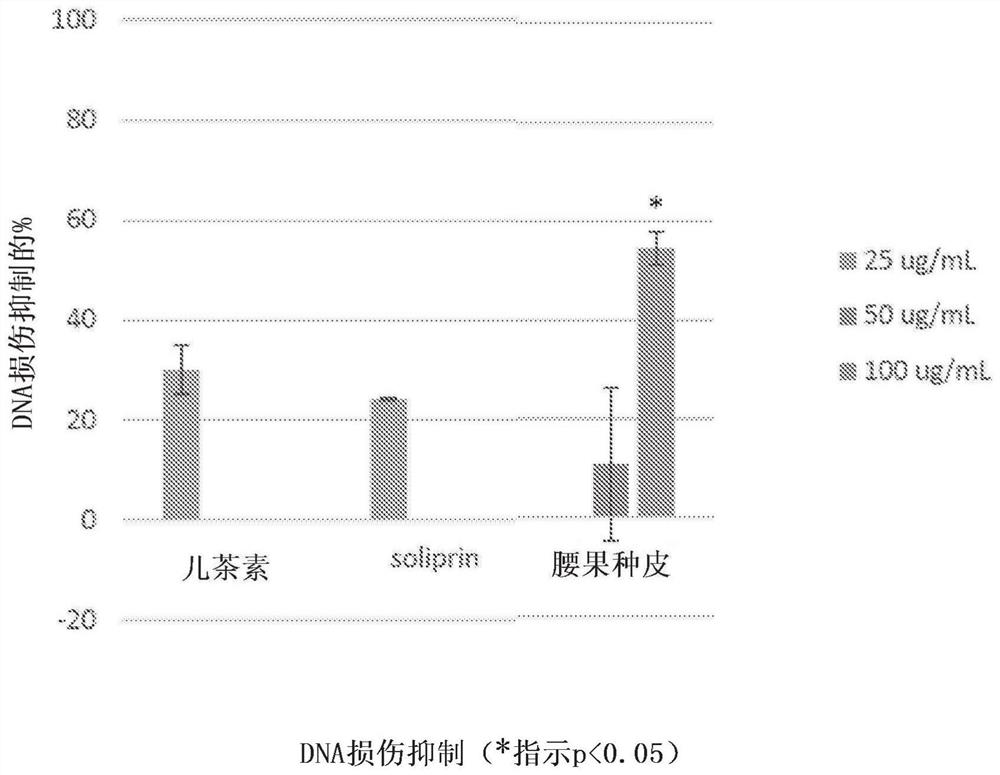Botanical antioxidants
A technology of anti-oxidation and plant extracts, which is used in the field of plant inhibitors as antioxidants and plant inhibitors of DNA damage, and can solve the problems of insufficient stability of antioxidants
- Summary
- Abstract
- Description
- Claims
- Application Information
AI Technical Summary
Problems solved by technology
Method used
Image
Examples
Embodiment 1
[0055] Example 1 - Preparation of cashew seed coat extract using 70% ethanol solvent
[0056] Dried cashew nut (Anacardium occidentale) seed coat powder (60 g) was filled into three 100 ml stainless steel test tubes, and was heated using a Thermo Scientific TM Dionex TM ASE 350 accelerated solvent extractor or two solvent extractions with 70% ethanol in DI water at a temperature of 80°C and a pressure of 1500 psi. Filter and collect the extract solution. The combined ethanol extract solutions were evaporated under vacuum with a rotary evaporator to give crude cashew seed coat extract.
[0057] The extraction results are provided in Table 1 below.
[0058] Table 1 - Extraction of cashew seed coat
[0059]
Embodiment 2
[0060] Example 2 - Catechin Quantification of Cashew Nut Seed Coat Extract
[0061] A C18 reversed-phase column ( 5μm C18(2) LC column 250x 4.6mm, available from Torrance, California, US), to determine the free catechins present in the cashew seed coat extract. For mobile phase A, the solvent was 0.10% phosphoric acid in water (“H 3 PO 4 "), and for mobile phase B, solvent B was acetonitrile ("ACN"), which was used for elution at a flow rate of 1.0 ml / min, and using UV absorption at 275 nm and a column temperature of 35 °C. Using The catechin reference standard was obtained from Sigma-Aldrich Co. The reference standard was dissolved in methanol ("MeOH"): 0.1% H 3 PO 4 (1:1 ratio), wherein the concentration of catechin (C1251) is 0.5 mg / ml, and the concentration of epicatechin (E1753) is 0.1 mg / ml. Test samples were prepared in volumetric flasks at a concentration of 2 mg / ml in 0.1% H containing 50% MeOH 3 PO 4 , sonicate until dissolved (approximately 10 minutes), ...
Embodiment 3
[0065] Example 3-Chemical analysis of cashew seed coat extract
[0066] Using ultrahigh pressure liquid chromatography ("HPLC") and mass spectrometry ( UPLC Class I and The GS-XT-QTof system, both available from Water Corporation, Milford, Massachusetts USA), determined the flavonoid compounds present in the cashew seed coat extract. The columns used are UPLC HSS T32.1x100mm, 1.8μm, column temperature is 40°C, sample temperature is 15°C. For the mobile phase, solvent A was 10% acetonitrile ("ACN") in water (containing 0.1% formic acid), and solvent B was ACN. The acquisition range was 100-1500 Daltons ("Da") and the acquisition mode was electrospray ionization ("ESI")(-). Table 3 below provides the HPLC conditions.
[0067] Table 3 - HPLC conditions for the analysis of cashew seed coat extracts
[0068] running time (min) Injection volume (μL) concentration 20.00 2.00 1mg / mL
[0069] Peak identification was based on accurate mass only. Digal...
PUM
 Login to View More
Login to View More Abstract
Description
Claims
Application Information
 Login to View More
Login to View More - R&D
- Intellectual Property
- Life Sciences
- Materials
- Tech Scout
- Unparalleled Data Quality
- Higher Quality Content
- 60% Fewer Hallucinations
Browse by: Latest US Patents, China's latest patents, Technical Efficacy Thesaurus, Application Domain, Technology Topic, Popular Technical Reports.
© 2025 PatSnap. All rights reserved.Legal|Privacy policy|Modern Slavery Act Transparency Statement|Sitemap|About US| Contact US: help@patsnap.com



